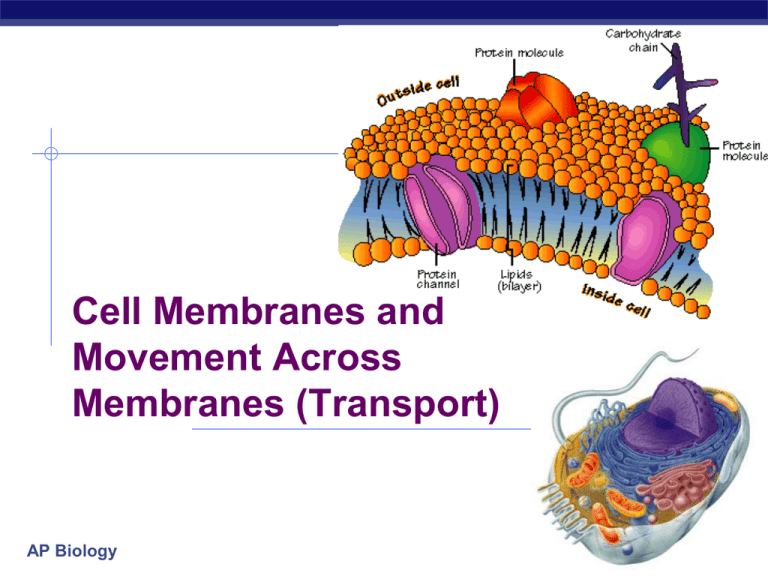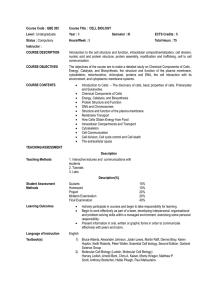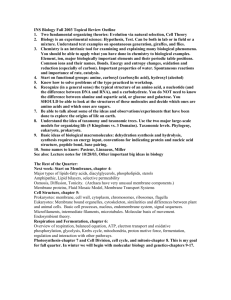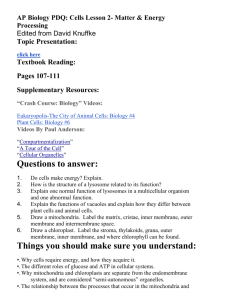Cell Membranes and Transport
advertisement

Cell Membranes and Movement Across Membranes (Transport) AP Biology 2005-2006 Cell Membrane…more than just a barrier! AP Biology 2005-2006 Cell (plasma) membrane Cells need an inside & an outside… separate cell from its environment cell membrane is the boundary Can it be an impenetrable boundary? NO! OUT IN food carbohydrates sugars, proteins amino acids lipids salts, O2, H2O AP Biology OUT IN waste ammonia salts CO2 H2O products 2005-2006 cell needs materials in & products or waste out Lipids of cell membrane Membrane is made of phospholipids phospholipid bilayer inside cell phosphate hydrophilic lipid hydrophobic outside cell AP Biology Phospholipid bilayer What molecules can get through directly? inside cell NH3 outside cell AP Biology lipid salt sugar aa H 2O fats & other lipids can slip directly through the phospholipid cell membrane, but… what about other stuff? Membrane Proteins Proteins determine most of membrane’s specific functions cell membrane & organelle membranes each have unique collections of proteins Membrane proteins: AP Biology peripheral proteins = loosely bound to surface of membrane integral proteins = penetrate into lipid bilayer, often completely spanning the membrane = transmembrane proteins 2005-2006 Membrane Protein Types Channel proteins – wide open passage Ion channels – gated, only active under specific conditions Aquaporins – move water only, found primarily in animal kidneys and plant roots Carrier proteins – conformational change (change in shape occurs) Transport proteins – require ATP AP Biology Membrane Protein Types Recognition proteins – glycoproteins, carbohydrates are attached (too hydrophilic to be directly on membrane) Adhesion proteins – anchors to surrounding cells/tissues Receptor proteins – hormones; receptors that start signal transduction pathways AP Biology A membrane is a collage of different proteins embedded in the fluid matrix of the lipid bilayer AP Biology 2005-2006 Membrane Carbohydrates Play a key role in cell-cell recognition ability of a cell to distinguish neighboring cells from another important in organ & tissue development basis for rejection of foreign cells by immune system AP Biology 2005-2006 Cholesterol Provides stability in animal cells Replaced with sterols in plant cells AP Biology Getting through cell membrane Passive transport No energy needed Movement down concentration gradient high low Active transport Movement against concentration gradient low high requires ATP Think: does it take more energy to move water down a waterfall (from high to low) or up a waterfall (from low to high)? AP Biology Diffusion Diffusion movement from high low concentration 2nd Law of Thermodynamics - Universe tends towards disorder AP Biology Simple diffusion across membrane Which way will lipid move? lipid inside cell low lipid lipid lipid lipid lipid high outside cell lipid lipid lipid lipid AP Biology lipid lipid lipid lipid 2005-2006 Diffusion of 2 solutes Each substance diffuses down its own concentration gradient, independent of concentration gradients of other substances AP Biology Facilitated diffusion Movement from HIGH to LOW concentration through a protein channel passive transport; no energy needed facilitated = with help AP Biology 2005-2006 Gated channels Some channel proteins open only in the presence of stimulus (signal) stimulus usually different from transported molecule ex: ion-gated channels when neurotransmitters bind to a specific gated channels on a neuron, these channels open = allows Na+ ions to enter nerve cell ex: voltage-gated channels change in electrical charge across nerve cell membrane opens Na+ & K+ channels AP Biology 2005-2006 Active transport Cells may need molecules to move against concentration situation need to pump against concentration protein pump requires energy ATP Na+/K+ pump in nerve cell membranes AP Biology Transport summary AP Biology 2005-2006 How about large molecules? Moving large molecules into & out of cell requires ATP! through vesicles & vacuoles Endocytosis (taking molecules in) phagocytosis = “cellular eating” pinocytosis = “cellular drinking” receptor-mediated endocytosis Exocytosis Molecules exiting AP Biology Exocytosis 2005-2006 Endocytosis phagocytosis pinocytosis receptor-mediated endocytosis AP Biology fuse with lysosome for digestion non-specific process triggered by ligand signal The Special Case of Water Movement of water across the cell membrane AP Biology 2005-2006 Osmosis is diffusion of water Diffusion of water from high concentration of water to low concentration of water AP Biology across a semi-permeable membrane 2005-2006 Concentration of water Direction of osmosis is determined by comparing total solute concentrations Hypertonic - more solute, less water Hypotonic - less solute, more water Isotonic - equal solute, equal water water hypotonic hypertonic net movement of water AP Biology 2005-2006 Managing water balance Cell survival depends on balancing water uptake & loss AP Biology freshwater balanced saltwater 2005-2006 Hypotonicity animal cell in a hypotonic solution will gain water, swell & possibly burst (cytolysis) Paramecium vs. pond water Paramecium is hypertonic H2O continually enters cell specialized organelle, contractile vacuole, pumps excess H2O out of cell; requires ATP plant cell in a hypotonic solution is turgid AP Biology Turgor pressure Cell wall exerts force Hypertonicity animal cell in hypertonic solution will lose water, shrivel & probably die salt water organisms are hypotonic compared to their environment they have to take up water & pump out salt plant cell in a hypertonic solution experiences plasmolysis Vacuole shrinks; cell membrane pulls AP Biology away from cell wall Wilting 2005-2006 Osmosis… .05 M .03 M Cell (compared to beaker) hypertonic or hypotonic Beaker (compared to cell) hypertonic or hypotonic Which way does the water flow? in or out2005-2006 of cell AP Biology Water Potential Water moves from a place of greater water potential to a place of lesser water potential (net). As the concentration of a solute increases in a solution, the water potential will decrease accordingly. Which has the greater water potential: Which has the greater water potential: AP Biology .2M or .8M? 20% or 80% water?






